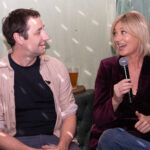A virtual news simulation that mimics the spread of disinformation in a crisis is training journalists to respond better to fake news.
First Draft launched the training in response to the rise of false and misleading information, spread through social media and some news outlets.
“Misinformation is sticky, once you hear it, it’s hard to forget,” said Esther Chan, APAC First Draft bureau editor, as participants beamed in remotely .
She added that although the disinformation and situation in the training was fictitious, “it speaks to the experience of our global team”.
From elections to global pandemics, disinformation has increasingly been dividing and confusing people around the world.
“When I first trained on the simulations I thought 90 minutes would be a long time but it flew by and felt like 10 minutes,” said Anne Kruger, Director of APAC First Draft.
“I was elated at the end, it felt like one of those days in the newsroom when it’s a busy news day that goes by in a flash!”
The training is designed to ignite dialogue and brainstorm creative solutions to the increasingly complex issue of disinformation.
“Our training generally begins with the ecosystem of information disorder and we outline the tools and techniques used by agents of disinformation and how the media can avoid being manipulated,” said Ms Kruger.
To get a better understanding of the training Central News attended one of First Draft’s virus crisis simulations.
Journalists face the challenge of conveying the gravity of the situation while avoiding spreading fear and panic
At the beginning of the call participants are briefed about a fictitious country, virus and one initial online rumour.
From tweets from foreign journalists and imposter content to memes, each time one issue was resolved, another arose.
“Journalists face the challenge of conveying the gravity of the situation while avoiding spreading fear and panic. Headlines, photos and data visualisations are three areas where newsrooms can make a difference with their choices,” said Ms Kruger.
Throughout the session new pieces of misinformation pop up on social media continuously and participants use break out rooms to plan their response.
“We discuss how media outlets can identify the ‘tipping point’ at which it becomes beneficial to cover disinformation, write about manipulated content and online extremism. Participants are encouraged to discuss local examples and context,” said Ms Kruger.

Anne Kruger, Director APAC First Draft
The experience provides a variety of perspectives. In our break out room we discussed each issue with communication professionals from Australia, Japan and India.
Coming from different backgrounds and discussing how our respective countries may respond, created a strong and engaging dialogue.
The simulation walked us through the seven main types of mis- and disinformation First Draft have identified through their work.
These seven categories include: satire, misleading content, imposter content, fabricated content, false connection, false content and manipulated content.
While these categories aren’t definitive, organising disinformation makes it easier to identify.
“The feedback and appreciation from the simulation was positive and shows given current circumstances in the world, this support is vital,” said Ms Kruger.
Main photo by Scott Graham/Unsplash




























